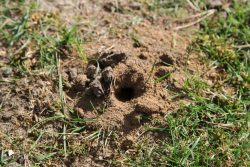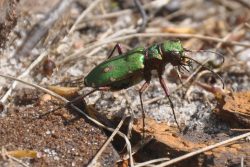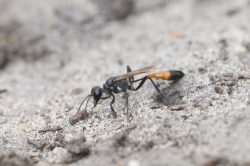Insects on the heath
June 29, 2017
The heaths of the South Downs can charm you at any time of year but during the summer months, when the purple heather blooms, they become magical places, ripe for exploration.
With so much to look out for we asked Bruce Middleton, who runs the Heathlands Reunited project, about some of the smallest characters to look out for on our heaths this summer.
Field cricket
I n the 1990s ecologists realised that there were less than 100 of the rare field crickets left in the UK – all living on the heath at Lord’s Piece common. Through a combination of captive breeding at London Zoo and translocation from the original site as part of a careful re-introduction programme, the tide is slowly turning. On a warm, early summer evening you can hear their chirruping song at Lord’s Piece.
n the 1990s ecologists realised that there were less than 100 of the rare field crickets left in the UK – all living on the heath at Lord’s Piece common. Through a combination of captive breeding at London Zoo and translocation from the original site as part of a careful re-introduction programme, the tide is slowly turning. On a warm, early summer evening you can hear their chirruping song at Lord’s Piece.
Minotaur beetle

Named after the mythological half-man, half-bull of ancient Greece, the male minotaur beetle has three ‘horns’ behind its head and enough strength to roll balls of dung 50 times its own weight over long distances. You might spot its home – a 1cm wide hole in the ground – but probably won’t see the larvae as these can be as deep as a metre feeding off dung rolled home by the minotaur.
Silver-studded blue butterflies

Look out for these butterflies between June and July and take a moment to think of the ‘deal’ they’ve made to reach adulthood safely. Their caterpillar feeds on young bell heath shoots, protected from predators such as sand wasps by black ants. When the caterpillar starts to pupate the ants will even carry it into their nest in return for a sweet honeydew which the ants ‘milk’ from the grub as payment.
Black darter dragonflies
These acid heathland and wetland specialists are better known for living in the West Country, but we are fortunate to have them on many of our greensand heaths. Black with yellow on their bodies, at just 29 to 34mm they are our smallest dragonfly.
Green tiger beetle

A bright green and cream-spotted wing case makes the green tiger beetle easy to spot, out sunning itself on heathland. They move quickly, running or flying, if disturbed and have fierce jaws that fit their aggressive, predator, lifestyle. Their larvae lie in wait for prey, concealed in vertical sandy burrows with only their jaws protruding.
Sand wasp
 Look out for female sand wasps dragging an immobilised caterpillar several times their size across the heath. This distinctive solitary wasp will find a sandy area to dig a burrow and store the caterpillar as live food for her young.
Look out for female sand wasps dragging an immobilised caterpillar several times their size across the heath. This distinctive solitary wasp will find a sandy area to dig a burrow and store the caterpillar as live food for her young.
Sand wasps grow up to 24mm with a distinctive narrow ‘waist’ and red and black abdomen.
“Our heaths were created by people thousands of years ago as they cleared trees and worked the land,” says Bruce Middleton, who runs the HLF-funded Heathlands Reunited project.
“The soil is poor, exhausted of nutrients, and plants and animals have had to evolve to meet this challenge. Some even require patches of bare earth in order to survive. Today, lowland heath is one of the most threatened habitats in the country – which puts these specialists under threat.”
One of the best ways to experience these heathlands is by following the winding route of the Serpent Trail, which snakes its way from Haslemere to Petersfield taking in more than twenty different heaths along its 103km (64 mile) route.
The National Park is running a free six-day guided tour of the trail from 17 to 22 July as part of the Heathlands Reunited project.
Find out more about the free guided Serpent Trail walk
Pick up a copy of the Serpent Trail guide from the South Downs Centre in Midhurst.
Heathlands Reunited is supported by the Heritage Lottery Fund and aims to bring existing heaths back to life and join up isolated ‘islands’ of heath so that rare wildlife such as the Dartford warbler, nightjar and natterjack toad can spread and thrive between them.
